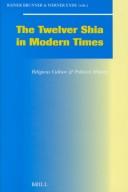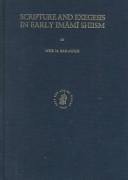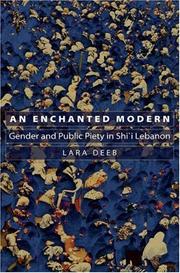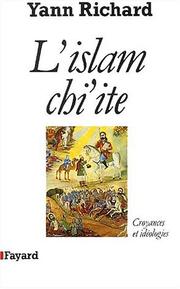| Listing 1 - 10 of 14 | << page >> |
Sort by
|
Book
ISBN: 0873952723 0873952731 Year: 1975 Publisher: Albany State university of New York press
Abstract | Keywords | Export | Availability | Bookmark
 Loading...
Loading...Choose an application
- Reference Manager
- EndNote
- RefWorks (Direct export to RefWorks)
Shiites --- Chiites --- 297 --- Shi'ah --- Islam. Mohammedanisme --- Imamites --- Shia --- Shiism --- Twelvers (Islam) --- Islamic sects --- Alids

ISSN: 13853376 ISBN: 9789004118034 9004118039 9789004492035 9004492038 Year: 2001 Volume: 72 Publisher: Leiden; Boston : BRILL
Abstract | Keywords | Export | Availability | Bookmark
 Loading...
Loading...Choose an application
- Reference Manager
- EndNote
- RefWorks (Direct export to RefWorks)
This volume - grown out of an international conference at Freiburg University in 1999 - deals with various aspects of Shiite Islam since the 18th century. It is divided into two major parts, the first of which is dedicated to traditional institutions of theology and learning and their transformation in modern times. The second part treats internal debates and the activities of Shiite dissidents, showing that Shiism is far from being uniform. Ideological and political developments in the 20th century and especially the Islamic Revolution in Iran have shaped the image of modern Shiism more than any other tendencies and are therefore also discussed in greater detail in Parts three and four. This book reflects the state of the art in this field of Islamic studies, its 21 contributions covering three centuries and a vast geographical range.
Imams (Shiites). --- Shiites. --- Shi'ah --- Imams (Chiites) --- Chiites --- Chiisme --- Political aspects. --- Doctrines. --- Aspect politique --- Doctrines --- Imams (Shiites) --- Shiites --- Shīʻah --- Political aspects --- Shīʻah --- Imāms (Chiites) --- Shia Muslims --- Shiah Muslims --- Shiahs --- Shias --- Shiite Muslims --- Muslims --- Imams --- Cultural aspects --- Shīʻah - Political aspects --- Shīʻah - Doctrines
Book
ISBN: 9782503531144 2503531148 Year: 2009 Volume: 137 Publisher: Turnhout: Brepols,
Abstract | Keywords | Export | Availability | Bookmark
 Loading...
Loading...Choose an application
- Reference Manager
- EndNote
- RefWorks (Direct export to RefWorks)
Au printemps 1968, lorsque la France et bon nombre d’endroits dans le monde étaient secoués par des mouvements de protestations sociopolitiques importants, quelques grands savants se réunissaient à la vieille et prestigieuse université de Strasbourg et allaient déclencher un véritable tournant dans les études islamologiques en Occident. En effet, pour la première fois, des chercheurs d’envergure mondiale se rencontraient dans un colloque exclusivement consacré au shi'isme imamite. Les conférences et les discussions aboutirent à la publication d’un excellent recueil d’articles: Le shî'isme imâmite: Colloque de Strasbourg (6-9 mai 1968), Presses Universitaires de France, Paris 1970.Si nous avons souhaité associer le 40e anniversaire de cet événement à l’hommage que nous voulions rendre à Etan Kohlberg, c’est pour souligner le rôle majeur de ce dernier dans l’enrichissement et l’approfondissement des études consacrées au shiisme imamite. En effet, l’ampleur de ses connaissances, la rigueur radicale de son érudition et ses grandes qualités humaines ont été des facteurs décisifs dans la diffusion des études shi'ites et leur transmission à travers la formation de générations entières de chercheurs.Ainsi, ce volume d’hommage se veut un témoignage de l’essor grandissant des études shi'ites imamites et de la dette indéniable de celles-ci aux savants réunis, il y a quarante ans, à Strasbourg, ainsi qu’à l’œuvre immense d’Etan Kohlberg.
Shiites. --- Shi'ah --- Chiites --- Chiisme --- Kohlberg, Etan. --- Shiites --- 297 <082> --- Islam. Mohammedanisme--Feestbundels. Festschriften --- Festschrift - Libri Amicorum --- Shīʻah --- Shia Muslims --- Shiah Muslims --- Shiahs --- Shias --- Shiite Muslims --- Muslims

ISBN: 9004114955 9789004114951 9789004452886 9004452885 Year: 1999 Volume: 37 Publisher: Leiden : Jerusalem : E.J. Brill The Magnes Press, the Hebrew University,
Abstract | Keywords | Export | Availability | Bookmark
 Loading...
Loading...Choose an application
- Reference Manager
- EndNote
- RefWorks (Direct export to RefWorks)
Since the publication in 1921 of Ignaz Goldziher's Die Richtungen der islamischen Koransauslegung , which includes a discussion of Imāmī exegesis, no comprehensive work on this topic has appeared. In the intervening years, important Imāmī commentaries on the Qur'ān have become available, making possible a reappraisal of the subject. The present study aims to contribute to this task, primarily by examining the features and methods of Imāmī exegesis. Principally, it offers a description and analysis of the major tenets of Imāmī doctrine, as reflected in the earliest Imāmī works of exegesis and related sources, up to the Major Occultation of the twelfth Imam in 329/941. These include, among others, the belief in a primordial covenant between God and the Shī'a, and the superhuman and mystical qualities with which the Imams were graced, such as their God-given, infinite knowledge, their intercession on behalf of their community, their immunity from sin and error, etc. Other tenets relate to the attitude of Imāmī Shī'ism to its enemies, e.g. the duty to denigrate and dissociate from them. These and similar ideas are constant motifs in Imāmī exegesis, and are linked time and again with various Qur'ānic verses. Relying on classical and modern Arabic sources, Sunnī and Shī'ī alike, as well as on a wide range of western research, Meir Bar-Asher sheds new light on the Imāmī methods of exegesis and on the principal Imāmī doctrines as reflected in the early Imāmī exegetical corpus.
Qur'an --- Commentaries --- History and criticism --- Criticism, interpretation, etc --- Imams (Shiites) - History. --- Shåi°ah - History. --- Imams (Shiites) --- Shiism --- History --- Imams --- Shīʻah --- Shiites --- Imamites --- Shia --- Twelvers (Islam) --- Islamic sects --- Alids --- Coran --- Imāms (chiites) --- Chiisme --- Critique, interprétation, etc. --- 10e siècle --- 11e siècle --- Histoire

ISBN: 0691124213 0691124205 9780691124216 Year: 2006 Publisher: Princeton Princeton university press
Abstract | Keywords | Export | Availability | Bookmark
 Loading...
Loading...Choose an application
- Reference Manager
- EndNote
- RefWorks (Direct export to RefWorks)
Based on two years of ethnographic research in the southern suburbs of Beirut, 'An Enchanted Modern' demonstrates that Islam and modernity are not merely compatible, but actually go hand-in-hand. This eloquent ethnographic portrayal of an Islamic community articulates how an alternative modernity, and specifically an enchanted modernity, may be constructed by Shi'I Muslims who consider themselves simultaneously deeply modern, cosmopolitan, and pious. In this depiction of a Shi'I Muslim community in Beirut, Deeb examines the ways that individual and collective expressions and understandings of piety have been debated, contested, and reformulated. Women take center stage in this process, a result of their visibility both within the community, and in relation to Western ideas that link the status of women to modernity. By emphasizing the ways notions of modernity and piety are lived, debated, and shaped by "everyday Islamists," this book underscores the inseparability of piety and politics in the lives of pious Muslims.
Shiites --- Islam and politics --- Women in Islam --- Chiites --- Islam et politique --- Femmes dans l'islam --- #SBIB:39A77 --- #SBIB:39A11 --- Etnografie: Noord-Afrika en het Midden-Oosten --- Antropologie : socio-politieke structuren en relaties --- Islam --- Shia Muslims --- Shiah Muslims --- Shiahs --- Shias --- Shiite Muslims --- Muslims --- Politics and Islam --- Political science --- Political aspects
Book
ISBN: 9781848856493 1848856490 Year: 2012 Publisher: London I.B. Tauris
Abstract | Keywords | Export | Availability | Bookmark
 Loading...
Loading...Choose an application
- Reference Manager
- EndNote
- RefWorks (Direct export to RefWorks)
Shi'ah --- Shiites --- Identity (Psychology) --- Religious life --- Chiisme --- Chiites --- Identité (Psychologie) --- Vie religieuse --- Religious aspects --- Islam --- Aspect religieux --- Shīʻah --- Identité (Psychologie) --- Imamites --- Shia --- Shiism --- Twelvers (Islam) --- Islamic sects --- Alids --- Personal identity --- Personality --- Self --- Ego (Psychology) --- Individuality --- Religious aspects&delete& --- Shiite authors --- Religious life (Islam)
Book
ISSN: 24177199 ISBN: 9782204118606 2204118605 Year: 2017 Publisher: Paris Les Éditions du Cerf
Abstract | Keywords | Export | Availability | Bookmark
 Loading...
Loading...Choose an application
- Reference Manager
- EndNote
- RefWorks (Direct export to RefWorks)
La 4e de couverture indique : "Qu'en est-il du droit islamique et des droits de l'Homme ? La loi révélée et le droit naturel sont-ils conciliables ? Entre antinomie et concordance, ces questions cruciales engagent singulièrement l'islam dans son rapport à la modernité. Le monde shi'ite au Liban, en Iraq, et surtout en Iran, en est un laboratoire. Depuis les années 1990, savants religieux et intellectuels s'attachent à penser cette dualité et poursuivent la controverse qu'elle engage. Qu'ils réexaminent de manière critique ou qu'ils réaffirment de manière vigoureuse leur fonds théologique et philosophique, tous oeuvrent à ce chantier juridique et politique sans précédent. Récapitulant les grandes étapes de la modernisation du droit de la Révolution constitutionnelle de 1906 à nos jours, en passant par 1979, s'appuyant sur l'ensemble des textes produits et sur les réflexions d'ayatollahs majeurs, Constance Arminjon Hachem offre un panorama inédit d'une mutation de la pensée islamique."
Civil rights (Islamic law) --- Human rights --- Shiites --- Religious aspects --- Islam --- Civil rights --- Human rights. --- Islam. --- Civil rights. --- Iran. --- Droits de l'homme (Droit islamique) --- Droits de l'homme (Droit international) --- Chiites --- Aspect religieux --- Droits --- 297.15 --- 297.15 Islam: ethiek; religieuze wetten --- Islam: ethiek; religieuze wetten --- Human rights - Religious aspects - Islam --- Human rights - Iran --- Shiites - Civil rights
Periodical
ISSN: 17489423 2051557X
Abstract | Keywords | Export | Availability | Bookmark
 Loading...
Loading...Choose an application
- Reference Manager
- EndNote
- RefWorks (Direct export to RefWorks)
Islam --- Shiites --- Shīʻah --- Chiites --- Shiites. --- Doctrines --- Study and teaching --- Politics and government --- Étude et enseignement --- Politique et gouvernement --- Study and teaching. --- Doctrines. --- 2000-2099 --- Mohammedanism --- Muhammadanism --- Muslimism --- Mussulmanism --- Religions --- Muslims --- Imamites --- Shia --- Shiism --- Twelvers (Islam) --- Islamic sects --- Alids --- Shia Muslims --- Shiah Muslims --- Shiahs --- Shias --- Shiite Muslims --- Islamic studies --- Chiisme

ISBN: 2213027439 9782213027432 Year: 1991 Publisher: Paris Fayard
Abstract | Keywords | Export | Availability | Bookmark
 Loading...
Loading...Choose an application
- Reference Manager
- EndNote
- RefWorks (Direct export to RefWorks)
Islam --- Chi'a --- Chi'isme --- Chia --- Chiisme --- Shi'ah --- Shi'ism --- Shiah --- Shiism --- Sji'a --- Sji'isme --- Sjia --- Sjiïsme --- Shīʻah --- Shiites --- Customs and practices --- Doctrines --- History --- 297.12 --- 297.17 --- 297 --- Islam: theologie; doctrine --- Islam: religieus geïnspireerde acties; fanatisme --- 297.17 Islam: religieus geïnspireerde acties; fanatisme --- 297.12 Islam: theologie; doctrine --- Chiisme duodécimain --- Imamisme --- Sh-i'ah --- shî'isme --- Chiisme. --- IRAN (ISLAMIC REPUBLIC OF). --- ISLAM. --- LEBANON. --- SHIITES. --- Schiiten. --- Shīʻah --- chiites --- Doctrines. --- Islam. --- Shīʻah - Customs and practices --- Shiites - Doctrines --- Shīʻah - History
Book
ISBN: 9789004442221 9789004442238 Year: 2021 Publisher: Leiden ; Boston : Brill,
Abstract | Keywords | Export | Availability | Bookmark
 Loading...
Loading...Choose an application
- Reference Manager
- EndNote
- RefWorks (Direct export to RefWorks)
"In Geschichtsschreibung im Handschriftenzeitalter, Philip Bockholt addresses the question of how history was written in the premodern Islamic world, and offers new insights into one of the most important chronicles composed in Persian, Khvāndamīrs universal history Habib al-siyar. Taking into account the political events which occurred in Iran and India around 1500, he examines the manuscript tradition of the work, and gives an in-depth analysis of how the author adapted his chronicle to the Shii and Sunni religio-political outlook of his Safavid and Mughal overlords. Making use of new approaches in the fields of history and philology, the work proves how texts were transmitted and modified for various audiences during premodern times.
Shīʻah. --- Sunnites. --- Khvānd Mīr, Ghiyās̲ al-Dīn ibn Humām al-Dīn, --- Islamic Empire --- Historiography. --- History --- Annals --- Auxiliary sciences of history --- Shīʻah --- Chiites. --- Khvānd Mīr, Ghiyās̲ al-Dīn ibn Humām al-Dīn, --- H̱wānd Mīr, Ġiyās̲ al-Dīn ibn Humām al-Dīn --- Empire islamique --- Historiographie. --- H̱wānd Mīr, Ġiyās̲ al-Dīn ibn Humām al-Dīn
| Listing 1 - 10 of 14 | << page >> |
Sort by
|

 Search
Search Feedback
Feedback About UniCat
About UniCat  Help
Help News
News